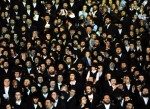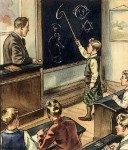 Zohar, Wikipedia:
Zohar, Wikipedia:
The Zohar (Hebrew: זֹהַר, lit Splendor or Radiance) is the foundational work in the literature of Jewish mystical thought known as Kabbalah.[1] It is a group of books including commentary on the mystical aspects of the Torah (the five books of Moses) and scriptural interpretations as well as material on Mysticism, mythical cosmogony, and mystical psychology. The Zohar contains a discussion of the nature of God, the origin and structure of the universe, the nature of souls, redemption, the relationship of Ego to Darkness and “true self” to “The Light of God,” and the relationship between the “universal energy” and man. Its scriptural exegesis can be considered an esoteric form of the Rabbinic literature known as Midrash, which elaborates on the Torah.
The Zohar is mostly written in what has been described as an exalted, eccentric style of Aramaic, which was the day-to-day language of Israel in the Second Temple period (539 BCE – 70 CE), was the original language of large sections of the biblical books of Daniel and Ezra, and is the main language of the Talmud.[2]
The Zohar first appeared in Spain in the 13th century, and was published by a Jewish writer named Moses de Leon. De Leon ascribed the work to Shimon bar Yochai (“Rashbi”), a rabbi of the 2nd century during the Roman persecution
Poisecution!
There are people of religions besides Judaism, or even those without religious affiliation, who delve in the Zohar out of curiosity, or as a technology for people who are seeking meaningful and practical answers about the meaning of their lives, the purpose of creation and existence and their relationships with the laws of nature,[7][8] and so forth; however from the perspective of traditional, rabbinic Judaism,[9][10] and by the Zohar’s own statements,[11] the purpose of the Zohar is to help the Jewish people through and out of the Exile and to infuse the Torah and mitzvot (Judaic commandments) with the wisdom of Kabbalah for its Jewish readers.
According to the Jewish Encyclopedia, “On the other hand, the Zohar was censured by many rabbis because it propagated many superstitious beliefs, and produced a host of mystical dreamers, whose overexcited imaginations peopled the world with spirits, demons, and all kinds of good and bad influences.”
Kabbalah, Wikipedia:
According to the Zohar, a foundational text for kabbalistic thought, Torah study can proceed along four levels of interpretation (exegesis).[5][6] These four levels are called pardes from their initial letters (PRDS Hebrew: פרדס, orchard).
- Peshat (Hebrew: פשט lit. “simple”): the direct interpretations of meaning.
- Remez (Hebrew: רמז lit. “hint[s]”): the allegoric meanings (through allusion).
- Derash (Hebrew: דרש from Heb. darash: “inquire” or “seek”): midrashic (Rabbinic) meanings, often with imaginative comparisons with similar words or verses.
- Sod (Hebrew: סוד lit. “secret” or “mystery”): the inner, esoteric (metaphysical) meanings, expressed in kabbalah.
Distinction between Jews and non-Jews
A number of medieval Kabbalistic sources contain statements to the effect that the Jewish soul is ontologically different from the soul of non-Jews; for example, it is held by some that Jews have three levels of soul, nefesh, ruach and neshamah while non-Jews have only nefesh.
Such theologically framed hostility may have been a response to some medieval demonization of Jews which developed in some parts of Western and Christian society and thought
David Halperin[62] argues that the collapse of Kabbalah’s influence among Western European Jews over the course of the 17th and 18th century was a result of the cognitive dissonance they experienced between the negative perception of Gentiles found in some exponents of Kabbalah, and their own positive dealings with non-Jews, which were rapidly expanding and improving during this period due to the influence of the Enlightenment.
However, a number of renowned Kabbalists claimed the exact opposite. In their view, Kabbalah transcends the borders of Judaism and can serve as a basis of inter-religious theosophy and a universal religion. Rabbi Pinchas Elijah Hurwitz, a prominent Lithuanian-Galician Kabbalist of the 18th century and a moderate proponent of the Haskalah, called for brotherly love and solidarity between all nations, and believed that Kabbalah can empower everyone, Jews and Gentiles alike, with prophetic abilities.
Yet another example of jewish duality – kabbalah is by jews, about jews, for jews AND it’s for everyone!
Cabal, by Rabbi Julian Sinclair, The Jewish Chronicle:
Cabal entered the English language in the late 16th century to mean a secret intrigue, plot or conspiracy. This coinage coincided with the rising awareness of Jewish mystical teachings, the Kabbalah, in non-Jewish circles. (The word Kabbalah derives from the word meaning “receive,” denoting the private, oral nature of its transmission from teacher to student.)
Kabbalah was at one time a bone of contention between ashkenazi jews in Eastern Europe. Misnagdim and the Hasidic Judaism, Wikipedia:
The reconciliation took place in response to the perceived even greater threat of the Haskala, or Jewish Enlightenment. Despite this, the distinctions between the various sects of Hasidim and other Orthodox Jews remain, although now, there is almost no conflict between these two groups.
In the mid-19th-century the influence of modern changes in Jewish society arrived East from the Western European secularising Haskalah (Jewish “Intellectualism”) movement. While the unsuccessful 1812 French invasion of Russia by Napoleon had sought to bring Jewish emancipation from the non-Jewish political structures of Poland and Russia, Haskalah sought to reform and rationalize Jewish thought and life from within the Jewish community, to form an image of Jewish observance in the character of non-Jewish modernity.
The threat of Haskalah helped heal the division between Hasidism and Mitnagdim, as they saw a common goal in protecting sincere Jewish observance of the common folk
The use of Hebrew for anything other than prayer and study is, according to them, profane. Hence Yiddish is the vernacular and common tongue for many Hasidim around the world.
Haredi Judaism, Wikipedia:
Haredim view themselves as the most authentic group of Jews
The word denotes staunchly Orthodox Jews and is increasingly being used in the diaspora in place of “ultra-Orthodox”, which some view as inaccurate or offensive,[16][17] it being seen as a derogatory term suggesting extremism.
Many Haredim view manner of dress as an important way to ensure Jewish identity and distinctiveness
To Zionists, Haredi Jews were either “primitives” or “parasites”; to Haredi Jews, Zionists were tyrannizing heretics.
Despite the animosity, it was necessary for the two groups to work out some modus vivendi in the face of a more dangerous enemy, the Nazis. This was achieved by a division of powers and authority, based on the division that existed during the British Mandate in the country. Known as the “status quo”, it granted political authority (such as control over public institutions, the army, etc.) to the Zionists and religious authority (such as control over marriage, divorce, conversions, etc.) to the Orthodox.
Why Do Some Jews Spell “God” G-d?, by Ariela Pelaia, judaism.about.com:
The custom of substituting the word “God” with G-d in English is based on the traditional practice in Jewish law of giving God’s Hebrew name a high degree of respect and reverence.
Significant names and contexts:
- YHWH/Yahweh (I am), not spoken ever
- Adonai (master, lord), prayer only
- HaShem (The Name), other times
Kabbalists use “Ein Sof”, meaning void, infinite, endless.
Atheist Jews: Judaism Without God, by Kimberly Winston, The Huffington Post:
In the 1920s, American Conservative Rabbi Mordecai Kaplan developed the theology of what would become Reconstructionist Judaism, founded on the idea that God is not personal, but a summation of all natural processes. Four decades later, Reform Rabbi Sherwin Wine came out as an atheist and founded “Humanistic Judaism,” which emphasizes secular Jewish culture and history over belief in God.
And because Judaism is not dogmatic — unlike Christianity and Islam, there is no creed to adhere to — atheists can be open about their lack of belief and still belong to a synagogue.
“Atheism is not much discussed in Jewish life,” said Jonathan Sarna, a professor of American Jewish history at Brandeis University.
“An individual who attends synagogue, participates in Jewish communal affairs, and contributes heavily to Jewish charities would undoubtedly be considered a very fine Jew, without asking questions about whether or not that person believed in God.”
Shaul Magid, a professor of modern Judaism at Indiana University, said atheists may join synagogues because American Judaism lacks “a vibrant secular Jewish movement.”
“They go because they want some kind of ethnic identity,” Magid said. “They don’t care about the prayers. It allows them to feel a sense of Jewishness, but has little to do with religion.”
That’s what prompted Jennifer Cohen Oko, a Washington, D.C.-based writer, to join a Reform synagogue, her first. Neither Cohen nor her husband believe in God, but, like many Jews, they joined for their two children.
“I want my kids to understand they are Jewish, to be proud of being Jewish and to understand their heritage,” Cohen said. “And then they’ll have a choice. If they want to go that way (towards belief in God), great. If they don’t, they’ll have a sense of where they came from.”
This article linked to Can There Be Judaism Without Belief In God?, Moment Magazine:
Rebecca Goldstein
As an atheist who identifies with my Jewishness, I believe this is a very important question. From a purely philosophical point of view, it might seem like a contradiction; Judaism is a religion that at the very least presupposes, as all religions do, a belief in God. But many of us make a distinction between Judaism as a religion and Judaism as a cultural and ethical outlook.
. . .
The contradictions might seem glaring, but centuries of Jewish history since the Haskalah, the Jewish Enlightenment, have proved that Jews are too strong for narrowly defined contradictions. One of the most important responsibilities a person has is to carefully and conscientiously examine her beliefs.
Robert Putnam
I don’t know whether it’s theologically kosher to be both a Jew and an atheist, but if it isn’t, half the Americans who call themselves Jews aren’t quite legit. Of self-identified Jews in the nationally representative surveys David Campbell and I did for our book American Grace, 50 percent say they have doubts about the existence of God. That figure is much higher among Jews than any other major religious group in America. (Among members of all other faiths, only 10-15 percent express any doubts at all about God’s existence.)
I’m a Jew by choice—I converted 50 years ago, and I’m even more satisfied with that choice now than I was a half-century ago. That’s partly because being Jewish is mostly not about beliefs, but about connections with other people, sharing values and a collective destiny.
Robert Putnam is the author of Bowling Alone: The Collapse and Revival of American Community and the Malkin Professor of Public Policy at Harvard University.
Avraham Infeld
Judaism is not a religion and was not a religion until the emancipation and our encounter with modernity. Rather, it’s the culture of the Jewish people. Like most ancient cultures, it was a religious culture, and the relationship between God and the Jewish people as a whole—not the individual Jew—was an integral part of the basis of that culture. Does an individual Jew have to believe in God to be a part of Judaism? I don’t think so. I believe that practicing Judaism demands recognition of the fact that you’re part of a culture with a narrative that has God as a central player, part of a people that have had a love affair with God for thousands of years. The narrative of this relationship is probably the central theme in the culture of this people. Being a people means identifying with a shared memory and narrative and having responsibility for its future, its renaissance, its well being. That’s what Jews are. It’s like asking “Can a Frenchman be French without being Catholic?” Of course he can, but he has to understand that being French was built on the Catholic tradition. We are taught that a Jew—never mind how he sins, even in the sin of apostasy—always remains a Jew. Jewish culture is not based on the individual Jew’s relationship to God, but rather on his relationship to his community and the community’s relationship to God: We pray in the plural. We need a minyan.
. . .
Membership in the people is the necessary condition for being a Jew (I don’t know if it’s sufficient), while saying, “your God is my God,” is not a requirement.
Masha Gessen
The concept of Jewishness as a religious affiliation is a recent one. It’s a post-World War II American idea, which will take years to unpack, but essentially it’s a cultural reaction to the need not to think of Jews as an ethnicity. The rest of the world thinks of Jews as an ethnic group, and to maintain a separate and cohesive population it’s useful to have a religion, but it’s not necessary, as other groups have demonstrated. The Roma have adopted whatever religion is dominant in the society in which they’re living, an unusual story for a small population in the diaspora, but possible. Same with the secular Jews of the Soviet Union. For nearly seven decades, Jews maintained a separate identity without religion and without a common language. The common experience of discrimination forged a common identity that bound them together.
Leora Batnitzky
It is difficult to conceive of Judaism as a long-term, sustainable tradition without belief in God, or, at the very least, belief in the Jewish people. For example, one of the questions about Zionism is whether or not, as a belief in the Jewish people outside of God, it is sustainable over the generations. I’m not sure it is. I’m not saying that all Jews do believe in God, and I don’t think God fills a void in any kind of easy way, but the notion of God gives some kind of trans-historical, or trans-subjective dimension to why we think we ought to do what we ought to do. The question comes down to what it means to sustain a belief in God in Judaism, and that’s a complicated issue. One interesting example of someone who struggled with this issue is Rabbi Mordecai Kaplan. He rightfully recognized that defining Judaism just in terms of God was problematic, and he also claimed that, in many ways, modern science made notions of God obsolete. But he continually struggled to think of a notion of God that infused Jewish peoplehood with meaning.
The question is, why be Jewish? One thing I think most Jews would agree on—and there aren’t many things—is that it’s not easy to be Jewish alone. It’s communal. So what sustains the community? Answers about history and culture are important, but without a God that somehow transcends human history, Judaism becomes just one cultural option among many. It becomes like ice cream flavors; different people like different flavors, but why should we force our children to like our flavor? Without God, arguments for Jewish continuity—that there should be Jews in the future—end up resorting to ethnic chauvinism.
Leora Batnitzky is chair of the Religion Department at Princeton University and author of How Judaism Became a Religion.
Jack M. Sasson
Especially before the fall of the Ottoman Empire, belief in God was generally not a troubling issue for Mizrachi Jews in the Middle East, as there was little differentiation between the religious and social spheres.
. . .
The Latin word religio (from which we derive “religion”) has to do with connectives, attaching people together. In that sense, an increasing investment in communal acts—synagogue worship and joyous occasions such as engagement, marriage, bar-mitzvah and brit milla—give moments in which members of the community renew their commitments to each other as well as distribute rewards to loyal members.
Jack M. Sasson is the Mary Jane Werthan Professor of Judaic and Biblical Studies at Vanderbilt University.
Judaism is based on people, not religion.
The podcast will be broadcast and available for download on Tuesday at 9PM ET.
Podcast: Play in new window | Download














